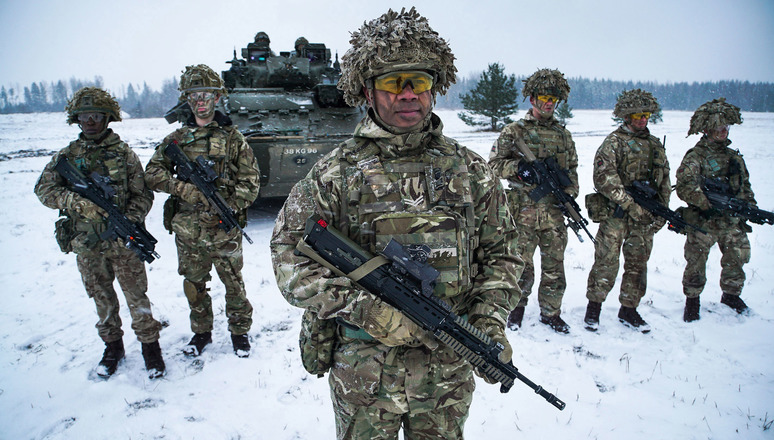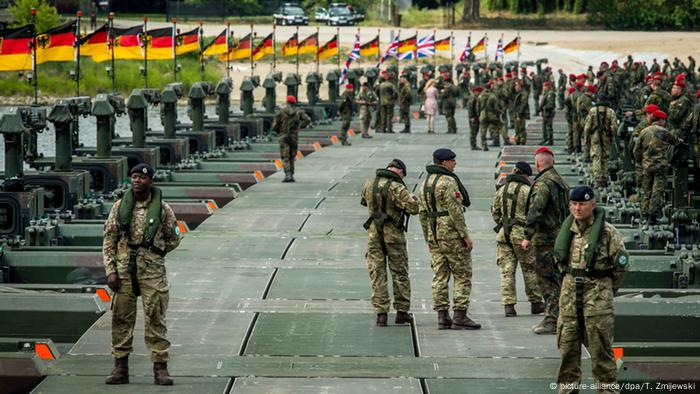
Germany’s Bundeswehr Joins NATO’s Exercises from the Arctic to the Mediterranean
Information on German Foreign Policy
BERLIN/BRUSSELS (March 25, 2022) — NATO is significantly expanding its troop presence in Eastern and Southeastern Europe. This is one of the outcomes of the most recent summit meeting of heads of states and governments of the military alliance convened yesterday (Thursday) in Brussels.
According to the agreement, the number of NATO battlegroups will be doubled due to the stationing of new units in Slovakia, Hungary, Romania, and Bulgaria; while more fighter aircraft, warships and aircraft carrier battle groups will be sent to the region. The Bundeswehr is involved in sending troops to Lithuania and Slovakia, as well as with providing Eurofighters and warships.
For years, hardliners have been pushing for these measures to be taken, and they were already in discussion before the escalation of the Ukraine conflict. Concrete steps were taken before the war began. There is resistance in some countries of the region. NATO troop locations form an arc stretching from the Baltic Sea to the Black Sea. Maneuvers, where NATO is currently practicing warfare, stretch from the high north to the Mediterranean.

Troop Presence Doubled
At yesterday’s NATO heads of states and governments summit in Brussels, it was decided to significantly expand the presence of the western alliance’s troops in Eastern and Southeastern Europe. According to the decision, four new NATO battlegroups — in Slovakia, Hungary, Romania, and Bulgaria — will be added to the four already existing in Estonia, Latvia, Lithuania, and Poland. NATO’s military locations, as Secretary General Jens Stoltenberg said yesterday, now form a long arc stretching “from the Baltic Sea to the Black Sea.”[1] Another buildup of troops is currently in discussion. According to reports, the NATO units in Eastern and Southeastern Europe “could be expanded to eight brigades.”[2]
A decision to this effect is expected to be taken in June at the NATO summit in Madrid. The western alliance will already increase its number of fighter jets in the eastern member countries charged with air policing, and deploy Patriot air defense batteries in some countries. In addition, more aircraft carrier battle groups, submarines and other warships will regularly enter the region.
According to Stoltenberg, the naval presence will extend “from the High North to the Mediterranean,” and if possible,[3], all the way into the Black Sea.

Participation of the Bundeswehr
The Bundeswehr is also involved in expanding NATO’s presence in Eastern and Southeastern Europe. Already on February 7, Germany’s Defense Ministry announced that the German involvement in NATO’s Lithuania battle group would be increased from 550 to 900 soldiers.[4]
Last week, the Bundeswehr announced it would be sending up to 700 soldiers, along with Patriot air defense batteries to Slovakia, to support the newly formed NATO battle group. The Bundeswehr is not disclosing the exact number of troops and the exact location “for security policy reasons.”[5]
The Air Force, on the other hand, continues to support air policing in the Baltic countries and additionally — already since last year — air policing over Romania and currently also over Poland. The Navy, for its part, has reinforced its activities in the Baltic Sea, immediately following Russia’s intervention in Ukraine, and concentrates on anti-mine measures, among other things.[6]
Germany plays an important role as the logistical hub for NATO relocations in the direction of Russia. For example, the logistical command, the Joint Support and Enabling Command (JSEC), located in Ulm, optimizes NATO troop movements on the European continent. [7]

Planned Years Ago
The expansion of NATO’s troop presence in Eastern and Southeastern Europe was planned before the war in Ukraine, even before the Ukraine crisis escalated, at the end of October 2021. Hardliners have long been pushing for stationing larger contingents of troops in the region.
In June 2020, for example, the former Supreme Commander of US Army in Europe (USAREUR) US Lt. Gen. (Ret.) Ben Hodges, demanded that an equivalent number of NATO Battle Groups be stationed in the Black Sea region to those in the Baltics and Poland. [8]
In late 2021, it became known that the realization of these plans was already quite advanced. As the implementation became concrete in mid-February 2022, resistance began to grow, this was the case, for example, in Slovakia, where the conclusion of a troop agreement with the USA met with strong protests. [9]
For the time being, it seems this resistance has been calmed — although not completely, and not everywhere. Observers, for example, point out that Hungary is still refusing to have a significant number of foreign NATO troops stationed there on a long-term basis. The battle group stationed in Hungary, should therefore be comprised almost entirely of Hungarian soldiers. In Bulgaria, the share of foreigners must also remain limited, and the command of the battle group remains with the national military.

Record-Breaking Maneuvers in the Arctic
NATO maneuvers currently taking place or having ended only a few days ago, provide good evidence of just how advanced NATO’s planning against Russia had been before the Ukraine conflict had escalated in the fall of 2021. Maneuvers were prepared in the course of many months.
For example, the combat exercise Cold Response 22 is being carried out in northern Norway, with the objective of exercising warfare under arctic conditions. Around 30,000 soldiers from 27 countries are participating, including several hundred from the Bundeswehr. This is the largest maneuver in the Arctic since the end of the Cold War.
Units of ground, air, and naval forces are involved, including two NATO carrier strike groups led by the US Navy aircraft carrier USS Harry S. Truman and Royal Navy aircraft carrier HMS Prince of Wales. [10] According to a preliminary report back in April 2021, the region of Norway’s Ofoten, where the Cold Response 22 exercise would be concentrated, is “of core strategic importance in case of a larger global conflict involving Russia in the North-Atlantic.” The area is about “600 kilometers from the Kola Peninsula” where the Russian Northern Fleet’s nuclear submarines are based. [11]

Anti-Submarine Warfare
The “Dynamic Manta 2022” maneuver ended on March 4. In this maneuver in the center of the Mediterranean, surface warfare was exercised, on the one hand, and anti-submarine warfare, on the other. Warships, submarines and aviation from altogether nine NATO countries took part. The Bundeswehr participated with units of its Naval Air Wing 3 “Graf Zeppelin.” [12]
Dynamic Manta is one of two regularly held series of NATO maneuvers, where anti-submarine combat is exercised. The second, is the “Dynamic Mongoose” and is exercised either off the coast of Northern Norway or near Iceland.
Dynamic Mongoose is carried out in a maritime region, where submarines of Russia’s Northern Fleet must cross, when they leave the Kola Peninsula to enter the Atlantic, whereas the area for Dynamic Manta is in relative proximity to the Bosporus and the Dardanelle, where Russian Black Sea submarines can enter the Mediterranean.
Footnotes
[1] Press conference by NATO Secretary General Jens Stoltenberg following the extraordinary Summit of NATO Heads of State and Government. nato.int 24.03.2022.
[2] Thomas Gutschker: Vier weitere Battlegroups. Frankfurter Allgemeine Zeitung 24.03.2022.
[3] Der Vertrag von Montreux aus dem Jahr 1936 erlegt Schiffen aus Nicht-Anrainerstaaten des Schwarzen Meeres klare Beschränkungen für die Durchfahrt durch die Dardanellen und den Bosporus auf.
[4] Bundeswehr entsendet mehr Truppen an NATO-Ostflanke. bmvg.de 07.02.2022.
[5] Bundeswehr verlegt Luftverteidigungskräfte in die Slowakei. bundeswehr.de 17.03.2022.
[6] Die Marine verstärkt die Minenabwehr in der Ostsee. Bundeswehr.de 28.02.2022.
[7] See also Das Military Mobility Project.
[8] Ben Hodges, Janusz Bugajski, Ray Woycik, Carsten Schmiedl: NATO Needs a Coherent Approach to Defending its Eastern Flank. warontherocks.com 12.06.2020. See also “A More United Front against Russia”
[9] See also Neue Hürden.
[10] Preparations ramp up for Norway’s largest exercise in 30 years. defbrief.com 02.03.2022.
[11] Thomas Nilsen: Norway to host biggest exercise inside Arctic Circle since Cold War. thebarentsobserver.com 14.04.2021.
[12] Dynamic Manta 2022 beendet. bundeswehr.de 16.03.2022.
Posted in accordance with Title 17, Section 107, US Code, for noncommercial, educational purposes.